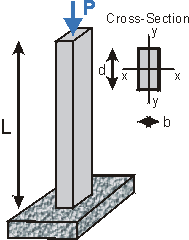Given: An aluminum (E = 70 GPa) column built into the ground has length, L = 2.2 m, and is under axial compressive load P. The dimensions of the cross-section are b = 210 mm and d = 280 mm.
Req'd:
(a) Determine the critical load to buckle the column.
(b) If the yield strength of the aluminum is 240 MPa, is the column more likely to buckle or to yield?
(c) If the factor of safety is F.S.=1.95, what is the allowable buckling load.


